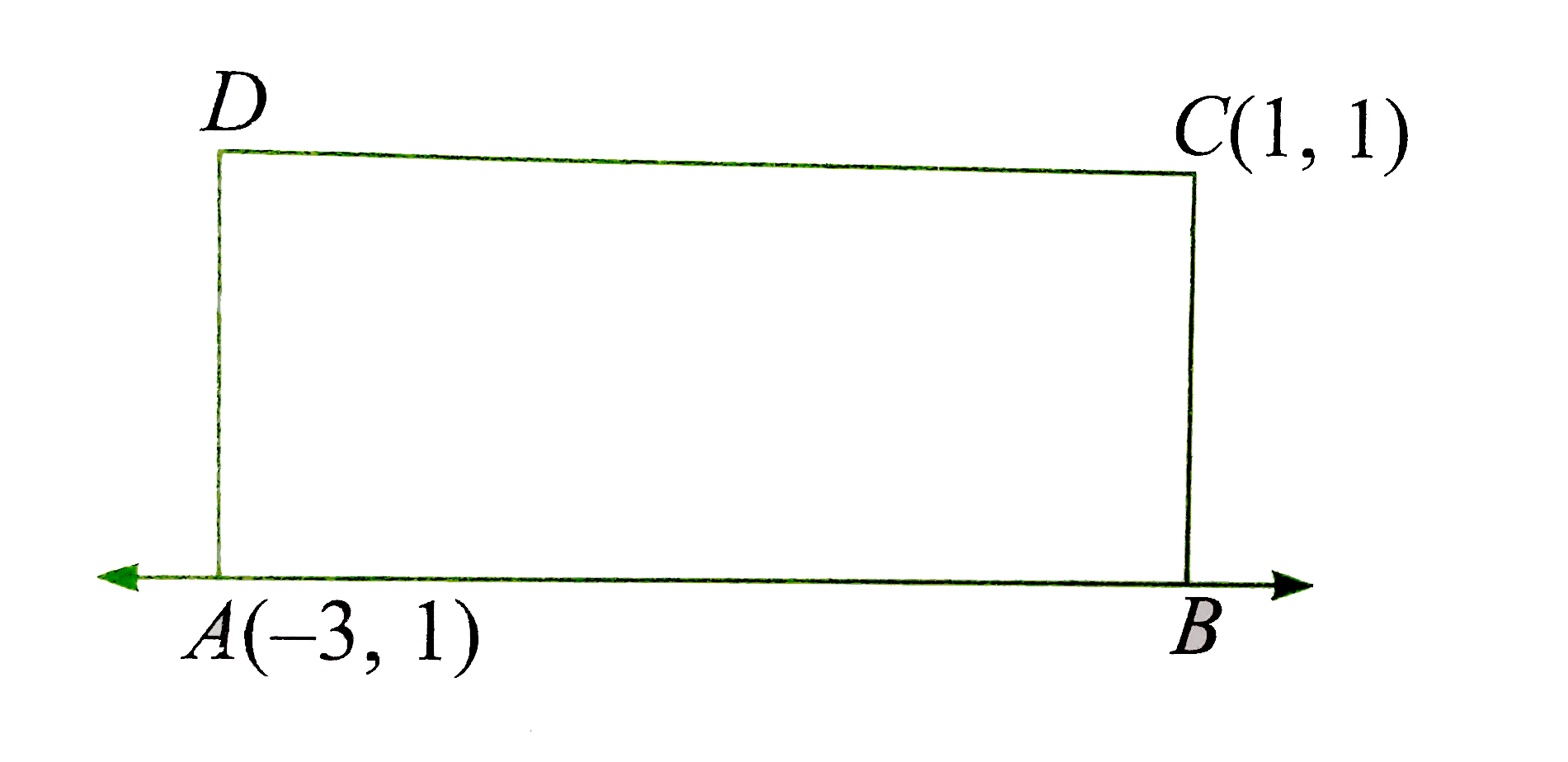One side of a rectangle lies along the line 4x+7y+5=0. Two of its vertices are (−3,1)and(1,1). Find the equations of the other three sides.
Let the side AB of rectangle ABCD lies along 4x+7y+5 = 0. As (-3,1) lies on this line, let it be vertex A. Now, (1,1) is either vertex C or D.

If (1,1) is vertex D, then the slope of AD is 0. Hence, AD is not perpendicular to AB. But it is a contradiction as ABCD is a rectangle. Therefore, (1,1) are the coordinates of vertex C.
CD is a line parallel to AB and passing through C. Therefore, the equation of CD is
y−1=−47(x−1)
or 4x+7y-11=0
Also, BC is a line perpendicular to AB and passing through C.
Therefore, the equation of BC is
y−1=74(x−1)
or 7x-4y-3=0
Similarly, AD is a line perpendicular to AB and passing through A(-3,1). Therefore, the equation of line AD is
y−1=74(x+3)
or 7x-4y+25 = 0
Topper's Solved these Questions
- STRAIGHT LINESBOOK - CENGAGECHAPTER - STRAIGHT LINESEXERCISE - Exercise 2.2
4 Videos
- STRAIGHT LINESBOOK - CENGAGECHAPTER - STRAIGHT LINESEXERCISE - Exercise 2.3
7 Videos
- STRAIGHT LINESBOOK - CENGAGECHAPTER - STRAIGHT LINESEXERCISE - JEE Advanced Previous Year
4 Videos
- STRAIGHT LINEBOOK - CENGAGECHAPTER - STRAIGHT LINEEXERCISE - Multiple Correct Answers Type
8 Videos
- THEORY OF EQUATIONSBOOK - CENGAGECHAPTER - THEORY OF EQUATIONSEXERCISE - JEE Advanced Previous Year
9 Videos
Similar Questions
One side of a rectangle lies along the line 4x+7y+5=0. Two of its vertices are (−3,1)and(1,1). Find the equations of the other three sides.
View SolutionOne side of a rectangle lies along the line 4x+7y+5=0. Two of its vertices are (−3,1)and(1,1). Then find the equations of other sides.
View Solution
Knowledge Check
One side of a rectangle lies along the line 4x + 7y + 5 = 0. Two of its vertices are (-3, 1) and (1, 1). Which of the following is not an equation of the other three straight lines?
A14x - 8y = 6B7x - 4y = -25C4 x + 7y = 11D14 -8y = - 25One side of a rectangle lies along the line 4x + 7y + 5 = 0. Two of its vertices are (- 3, 1) and (1, 1). Which of the following may be an equation which represents any of the other three straight lines?
A7 x - 4y = 3B7x - 4y + 3 = 0Cy + 1 = 0D4x + 7y = 3If one of the diagonals of a square is along the line x=2y and one of its vertices is (3, 0), then its sides through this vertex are given by the equations (A) y−3x+9=0,3y+x−3=0 (B) y+3x+9=0,3y+x−3=0 (C) y−3x+9=0,3y−x+3=0 (D) y−3x+9=0,3y+x+9=0
Ay−3x+9=0,3y+x−3=0By+3x+9=0,3y+x−3=0Cy−3x+9=0,3y−x+3=0Dy−3x+3=,3y+x=9=0
The equation of one side of a rectangle is 3x−4y−10=0 and the coordinates of two of its vertices are (−2,1)and(2,4). Find the area of the rectangle and the equation of that diagonal of the rectangle which passes through the point (2,4).
View SolutionThe equation of one side of a rectangle is 3x−4y−10=0 and the coordinates of two of its vertices are (−2,1)and(2,4). Then, the area of the rectangle is
View SolutionAn equilateral triangle has its circumcentre at origin and one of the sides is along the line x + y -1 = 0 and cordinate of vertex A is (-1,-1). Find the equations of the other two sides.
View Solutionnd (, The eqn of two sides of a triangle are 3x-2y + 6-0 and 4x + 5y = 20 and the orthocentre is (1,1). Find the equation of the thired side.
View SolutionIf the lines represented by 2x2−5xy+2y2=0 be the sides of a parallelogram and the line 5x+2y=1 be one of its diagonal. Find the equation of the other diagonal, and area of the parallelogram .
View Solution
